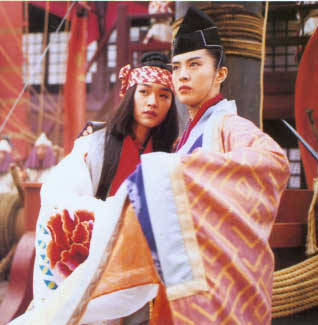Invincible Asia Saga


"...Yin and yang cannot coexist, the way as the light and day doesn't coexist with the darkness of the night—they alternate. But there is a moment when light and darkness intersect, the crepuscule. This moment does not last but only represents a passage point, a sort of interface with mediates the change of phase."
—Jean Chiriac,
Yin and Yang

This crepuscule—or passage point—is Swordsman 2. The very character of Asia The Invincible is changing from a male into a female. This metamorphosis is represented by moth imagery and Asia's voice changing from a man's voice into a woman's. Towards the beginning of the film, Ling begins playing his favorite song, "Hero of Heroes" and we hear a male voice singing the first verse. Then we hear a female's voice singing the second verse (Chief Ying’s). Once again, the masculine shifting into the feminine. Despite the symbolism that is attached to Asia The Invincible's transformation in the film, for all direct purposes, Asia is a woman. The viewer is introduced to her character after the metamorphosis is nearly complete. Asia is played by a woman, because by this point, she looks like a woman. This is why Ling is taken in by her. And this is why Asia and Ling's interaction throughout the film can be viewed as the Yin and Yang principles interacting for a brief moment between the day (Swordsman) and night (The East Is Red) of the trilogy. The film's tone shifts between lightness and darkness moreso than the other two: Offering an atmosphere that echoes the lighthearted antics of the first film, but foreshadows the bleak melancholia of the third film. In every way possible, Swordsman 2 is the halfway point between the lightness (Yang) and the darkness (Yin). But these two opposite principles cannot coexist for very long and the dominance of one over the other must eventually take place in order to maintain universal balance.

And so, The East Is Red is an offering that is completely dominated by the Yin principle. Ying's character does not appear in the film (as Asia The Invincible did not appear in the first film) and Asia The Invincible is instead the focus. The East Is Red is also the darkest and most maniacal installment. In many ways, it is the exact opposite of the first Swordsman film.

Further supporting this interpretation of the trilogy is the fact that the Sun Moon Sect is the only constant—being featured in all three films. As mentioned, Yang encompasses the sun and Yin encompasses the moon. Moreover, Asia The Invincible's character is visually associated with the moon. Perhaps the use of the Sun Moon Sect as a linking device for the three films was a subtle clue to the spiritual and philosophical subtext of the trilogy? Was this all part of some grand ambition on Tsui Hark's part or was it simply the Eastern subconscious at work? No matter which scenario holds true, what Tsui Hark and his collaborators have left us is a mythology that only crystallizes and strengthens upon multiple viewings and examination.

In my opinion, the greatest film trilogy of
all time.
